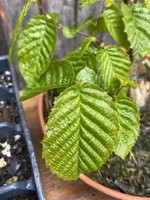Gabler
Masterpiece
After a nearly-disastrous run-in with pine sawflies last summer, I purchased some bulk cold-pressed neem oil this spring to spray as a prophylactic. It has also been working well as a preventative for the rust that bounces back and forth between my eastern red cedar and hawthorn. Neither has shown any symptoms since I began spraying, though it could also be the lingering effects of the Daconil I used for two treatments when an orange alien gall showed up in early March.
I started with a pre-mixed spray bottle of neem oil, and I sprayed with excellent results. When that ran out, I diluted some straight, cold-pressed neem oil with water using a squirt of Dawn dish detergent as an emulsifier. Almost all of my trees are still in development, so they've been growing vigorously, and I haven't worried too much about creating "ideal" conditions for those trees, given how healthy they are when allowed to grow unrestrained. Good enough has been good enough. Accordingly, I didn't bother measuring out the neem oil to the exact specifications on the bottle; I just eyeballed it.
When I sprayed my trees, everything looked normal for the next few days, except the trees never looked completely dry after I sprayed them. The oil coated the leaves causing them to appear perpetually damp. Subsequently, some of my trees appear to have suffered from sunburn (or is it chemical a chemical burn?), with brown patches along creases in the leaves where more solution would have settled on the leaf. I can't be certain it was the neem oil that did it, but just as tanning oil increases sun exposure on the skin, I suspect the excess neem oil increased sun exposure to the plant leaves. Where normally leaves are a little bit reflective like glossy paper, they were a deep matte green, without any shine. I suspect the mechanism is similar to oil on a napkin. When the napkin is dry, it's opaque. Use it to clean up some spilled olive oil, and you can see through it.
Since I'm still a novice compared to the lot of you, I could be mistaken, so I'll post some pictures (to follow this post) so you can judge for yourselves and weigh in. You'll see that it has most effected those leaves exposed to the most direct sunlight, though it is also possible that these are the same leaves which were exposed to the most spray from above.
I started with a pre-mixed spray bottle of neem oil, and I sprayed with excellent results. When that ran out, I diluted some straight, cold-pressed neem oil with water using a squirt of Dawn dish detergent as an emulsifier. Almost all of my trees are still in development, so they've been growing vigorously, and I haven't worried too much about creating "ideal" conditions for those trees, given how healthy they are when allowed to grow unrestrained. Good enough has been good enough. Accordingly, I didn't bother measuring out the neem oil to the exact specifications on the bottle; I just eyeballed it.
When I sprayed my trees, everything looked normal for the next few days, except the trees never looked completely dry after I sprayed them. The oil coated the leaves causing them to appear perpetually damp. Subsequently, some of my trees appear to have suffered from sunburn (or is it chemical a chemical burn?), with brown patches along creases in the leaves where more solution would have settled on the leaf. I can't be certain it was the neem oil that did it, but just as tanning oil increases sun exposure on the skin, I suspect the excess neem oil increased sun exposure to the plant leaves. Where normally leaves are a little bit reflective like glossy paper, they were a deep matte green, without any shine. I suspect the mechanism is similar to oil on a napkin. When the napkin is dry, it's opaque. Use it to clean up some spilled olive oil, and you can see through it.
Since I'm still a novice compared to the lot of you, I could be mistaken, so I'll post some pictures (to follow this post) so you can judge for yourselves and weigh in. You'll see that it has most effected those leaves exposed to the most direct sunlight, though it is also possible that these are the same leaves which were exposed to the most spray from above.








